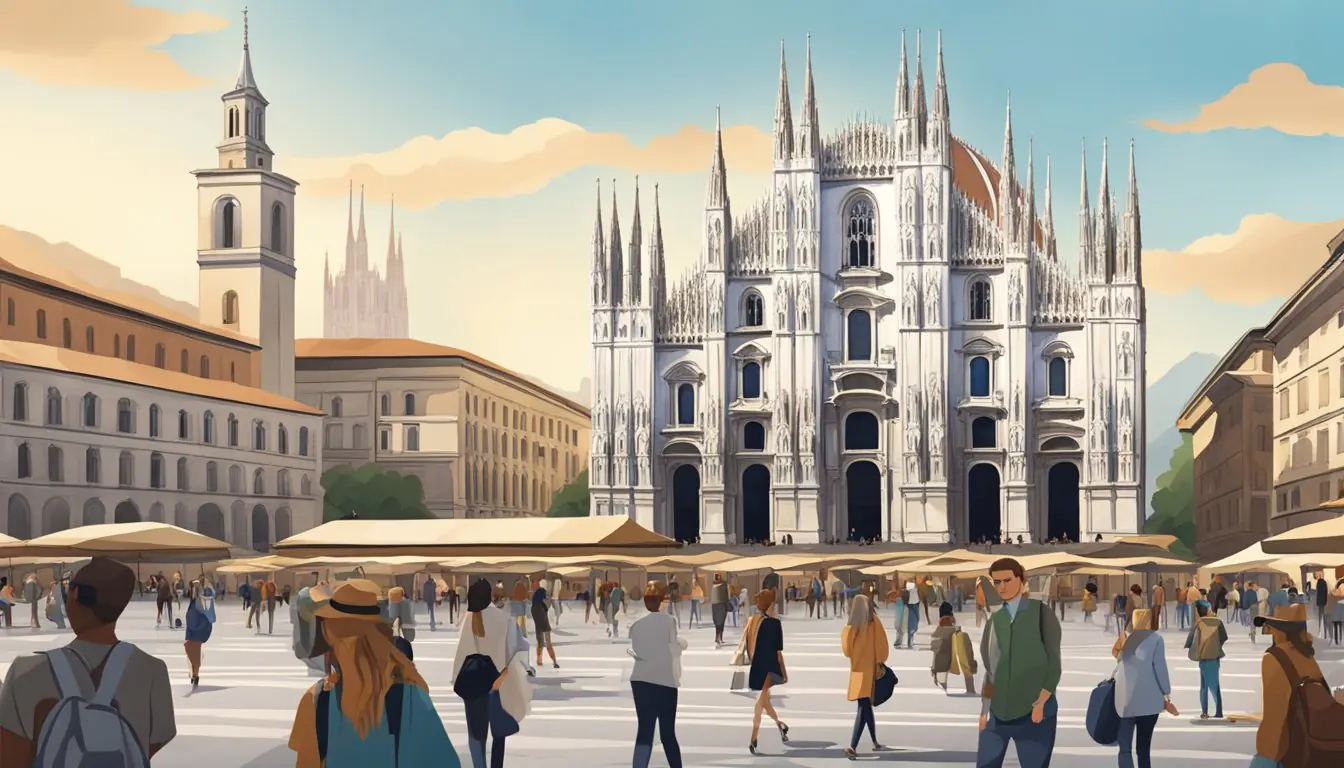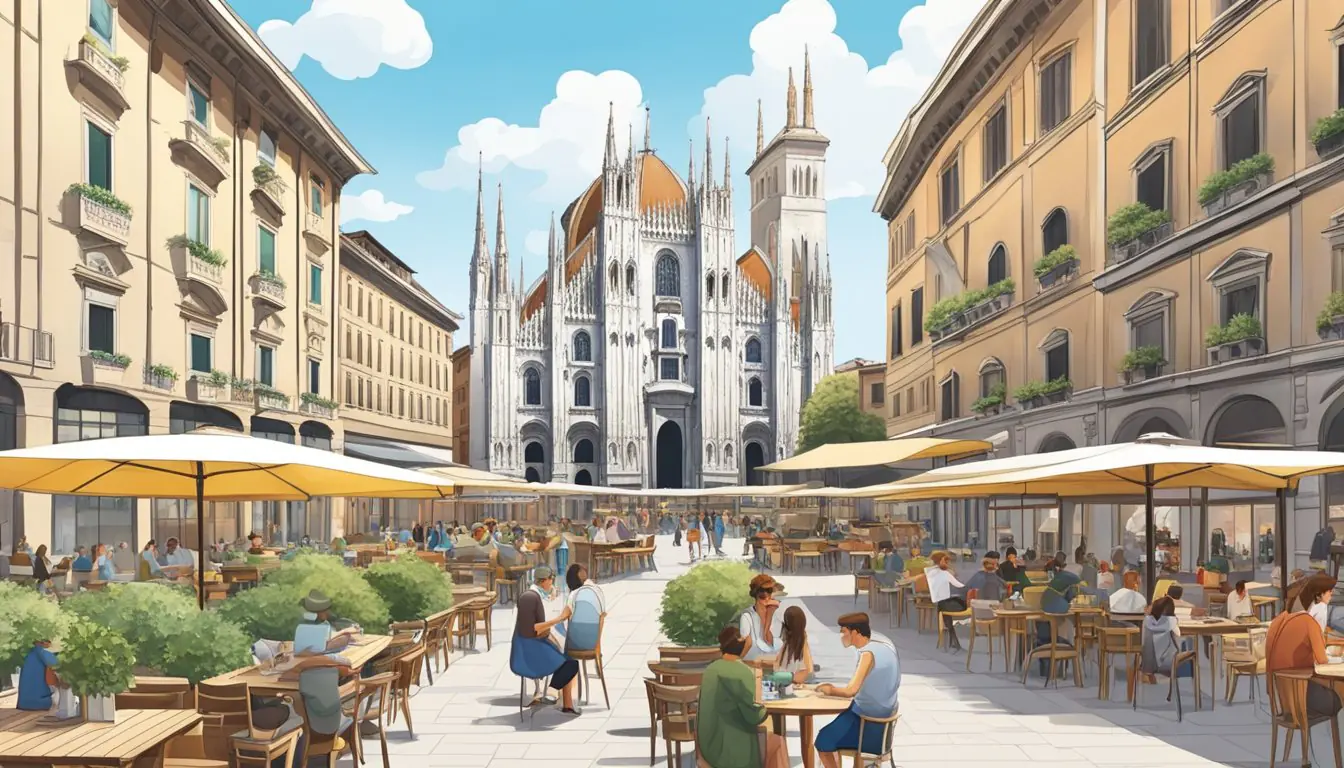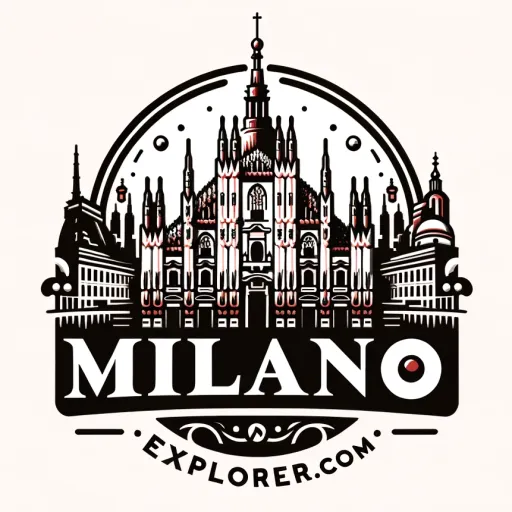Milan, a bustling metropolis in Italy, stands as a beacon for travelers who are magnetized by its rich tapestry of history and culture. As a city that has stood at the forefront of art and design, its streets and buildings tell a story of past grandeur and contemporary elegance.
Visitors to Milan have the opportunity to immerse themselves in a cultural experience that couples the grandiosity of historical landmarks with the verve of a modern lifestyle.

When it comes to historical landmarks, Milan does not disappoint. The Duomo di Milano, with its striking Gothic architecture and jaw-dropping interior, offers a glimpse into the city’s religious and architectural significance.
Not far behind in the list of must-visit attractions is the Galleria Vittorio Emanuele II, which exudes the charm of 19th-century Italy and stands as a monument to the country’s design heritage.
Furthermore, the city’s interconnectedness, through its efficient transportation network, makes exploring these attractions convenient for any traveler, offering a seamless blend of discovery and leisure.
What to visit in Milan
Key Takeaways
- Milan is a culturally rich Italian city that intertwines historical elegance with modern-day vibrancy.
- The city boasts significant landmarks like the Duomo di Milano that encapsulate its religious and architectural heritage.
- Milan’s comprehensive transportation system facilitates easy access to its diverse array of attractions.
History and Culture
Milan’s storied past is intricately linked with seminal figures like Leonardo da Vinci and Napoleon, while its thriving cultural scene reflects a city grounded in rich traditions yet perpetually pushing into the future.
Historical Significance
Milan’s history is a tapestry woven through time, from its Roman foundations to its strategic importance in the Middle Ages. It has been the backdrop for significant events, such as the rule and subsequent defeat of Napoleon.
The city’s architectural splendor narrates these historical epochs, with edifices like the Duomo di Milano representing centuries of devotion and artistry. Visitors can also explore the remnants of its ancient Roman roots at various sites throughout the city.
Cultural Impact
The cultural fabric of Milan is inseparable from its history. The city served as a canvas for Leonardo da Vinci, whose indelible mark is seen at the Santa Maria delle Grazie, home to the iconic The Last Supper.
Milan’s cultural influence extends through its prestigious opera house, La Scala, and the numerous museums and galleries that showcase a blend of historical artistry and contemporary creativity.
Each cultural institution attests to Milan’s ongoing role as a central hub for the arts within Italy and beyond.
Major Attractions
Milan, a metropolis in Italy’s northern Lombardy region, is distinguished by its rich cultural heritage and iconic architectural landmarks. Attracting millions of visitors annually, Milan’s major attractions offer a glimpse into the city’s glorious past and vibrant artistic scenes.
Gothic Architecture
Duomo di Milano
The Duomo di Milano stands as a breathtaking example of Gothic architecture. Dominating the Piazza del Duomo, this imposing cathedral is known for its intricate marble façades and the golden Madonnina statue perched atop its highest spire.
Galleria Vittorio Emanuele II
Adjacent to the cathedral, the Galleria Vittorio Emanuele II is one of the world’s oldest shopping arcades. A marvel of 19th-century engineering, this grand galleria dazzles with its glass-vaulted ceilings and mosaic floors, housing luxury retailers and historic cafés beneath its roof.
Museums and Galleries
Last Supper & Art Galleries
Taking pride in Milan’s art scene is the Church of Santa Maria delle Grazie, the repository for Leonardo da Vinci’s iconic fresco, The Last Supper.
Meanwhile, the Pinacoteca di Brera is a premiere art gallery showcasing a vast collection of Italian Renaissance art, situated in the heart of the Brera district.
Museums
Science enthusiasts should not miss the Leonardo da Vinci National Museum of Science and Technology, celebrating the genius of Da Vinci with an array of interactive exhibits.
Additionally, Castello Sforzesco hosts a collection of museums documenting Milan’s storied history, from ancient art to musical instruments.
Art and Design
Milan, a city steeped in artistic heritage and contemporary design, offers a rich tapestry of visual wonders. As a nexus of creativity, it has been a focal point for both classical artworks and world-leading fashion design.
Notable Artworks
In terms of classical paintings, Milan is a treasure trove of Renaissance masterpieces.
The Last Supper, Leonardo da Vinci’s revered mural, graces the refectory of the Santa Maria delle Grazie, and is a must-see for art enthusiasts.
Additionally, the Pinacoteca di Brera hosts an impressive collection including works by Raphael and Caravaggio. The Brera district is also home to countless galleries showcasing the evolution of Italian art.
For those with a keen interest in sculptures, the Museo del Novecento is well-known for its array of modern artworks, situated within the distinctive architecture of the Palazzo dell’Arengario.
Milan’s churches and cathedrals are also adorned with historical sculptures, among them the haunting figure of St. Bartholomew Flayed.
Design and Fashion
Milan is Italy’s fashion capital, enticing fashionistas with its prestigious boutiques and design houses.
Featuring names like Prada and Gucci, the Quadrilatero della Moda – particularly Via Montenapoleone – is a luxury shopping mecca. The area is acclaimed for its high concentration of jewellers, haute couture, and showrooms.
The Navigli district echoes with design diversity, embracing the innovative spirit of modern designers and artists.
Milan’s fashion prowess is further embodied by Giorgio Armani, whose influence is palpable across the city.
As an incubator for fashion and design, the city’s influence extends globally, maintaining its standing as an unparalleled hub for those who appreciate the intricacies of cutting-edge design and historical fashion narratives.
Leisure and Recreation
Milan offers a wealth of options for leisure and recreation, pairing serene parks and open spaces with a thriving shopping and cuisine scene. Visitors have opportunities to unwind amidst lush greenery or indulge in the cosmopolitan offerings of this vibrant city.
Parks and Open Spaces
Milan is home to several beautiful parks, offering a tranquil escape from the urban hustle.
Among them, Parco Sempione is a prominent green oasis in the heart of the city, featuring walking paths, a tranquil pond, and the striking Arco della Pace. It’s an ideal spot for leisurely strolls or picnics.
Another innovative green space is the Bosco Verticale, translated as ‘Vertical Forest’, an award-winning residential complex adorned with more than 900 trees and a variety of plants and shrubs integrated into its design.
Shopping and Cuisine
For those seeking a premier shopping experience, Milan does not disappoint.
The iconic Galleria Vittorio Emanuele II is not only one of the world’s oldest shopping malls but also a stunning architectural sight. Visitors can explore luxury boutiques and stop at elegant cafés to enjoy a coffee or traditional Italian gelato.
Milan’s Navigli district, specifically along Naviglio Grande, is a lively area especially in the evenings, filled with unique eateries and bars lining the canals, capturing Milan’s indulgent and leisurely lifestyle.
Religious and Historic Sites
Milan, a city steeped in history and culture, is home to numerous religious and historic sites that offer tourists panoramic views, architectural wonders, and a deep sense of the past. From the roofs of grand cathedrals offering breathtaking sights to sacred spaces bearing centuries-old art, these landmarks are integral to understanding Milan’s heritage.
Churches and Basilicas
Milan’s Duomo is much more than a church; it is a veritable treasure trove of art and history.
Its rooftop delivers a panoramic view that spans the entirety of the city, making it a must-see for any visitor. Inside, the heart of Milan’s spiritual life and grandeur can be felt, especially within the Basilica di Sant’Ambrogio, known as a cornerstone of Milanese ecclesiastical tradition.
Another hidden gem, the Church of San Maurizio al Monastero Maggiore, houses impressive frescoes and is often referred to as the ‘Sistine Chapel of Milan’.
Similarly, the humility and tranquillity of San Bernardino alle Ossa with its ornate ossuary, present an unparalleled historical experience.
Connectivity and Transport
Milan offers a robust and efficient public transport system that caters to both inhabitants and tourists.
The network includes the metro system, trams, and buses, ensuring connectivity throughout the city and to notable landmarks.
Local Transit Options
Milan’s public transport network is one of the most comprehensive in Italy, serving the entire Lombardia province effectively.
The metro system spans across the city with four lines, labeled M1 to M5, and is a popular choice for visitors trying to reach destinations like the historical San Siro Stadium or the Palazzo della Ragione.
Trams offer a scenic view of the city as they pass through major hubs and near the bustling Piazza Affari.
Buses complement the tram and metro services, connecting areas that might not be directly accessible by rail.
For those wishing to explore beyond the city limits, the regional train network stretches to picturesque locations such as Lake Como, giving travelers an easy route to one of Italy’s most breathtaking natural attractions.
Traveler Information
For those visiting Milan, understanding the ticketing system is crucial.
Single tickets are valid for 90 minutes from the time they are validated, allowing users to switch between modes of transport within this period.
Additionally, multiple-day passes offer unlimited travel and can be a cost-effective option for tourists planning extensive exploration.
Most ticket types can be purchased at metro stations, via official apps, or at authorized outlets throughout the city.
In an effort to offer a more sustainable travel option, Milan has introduced eco-friendly buses into its fleet, further cementing the city’s commitment to the environment and green travel.
Conclusion

Tourists will find that Milan offers a remarkable array of historical landmarks, each telling a different story of the city’s rich heritage.
Visitors should not miss the opportunity to see the Duomo di Milano, an iconic landmark that stands as a symbol of Milanese spirit and architectural ingenuity.
With its grandeur and religious significance, it exemplifies the quality of historic and cultural identity found in Milan.
In addition to the cathedral, the Galleria Vittorio Emanuele II offers tourists a glimpse into Milan’s luxurious past and present, combining history with upscale shopping.
Its beauty and structure captivate all who walk beneath its glass-vaulted arcades.
Exploring Milan further, one encounters a wealth of historical sights that showcase the city’s role as a commercial hub throughout the ages, with its strategic location and network of canals enhancing its economic strength.
The canals themselves, remnants of a booming era of industry and commerce, provide an insight into the evolution of Milan over the centuries.
Final thoughts for those touring Milan should include the encouragement to immerse themselves in the city’s historic narrative.
Tourists are advised to pace their visit to absorb the rich cultural tapestry that is Milan, taking the time to appreciate the finer details of its landmarks.
Whether it’s for the art, history, or architecture, Milan’s landmarks stand as testaments to human creativity and endeavor.
Frequently Asked Questions

Milan’s rich tapestry of history is woven into its stunning landmarks, each telling a unique story of the city’s past. Tourists can explore a multitude of iconic buildings and monuments that define Milan’s historical significance.
Which historical buildings are a must-see when visiting Milan?
When in Milan, the Milan Cathedral, also known as the Duomo di Milano, is an architectural marvel not to be missed.
Another essential visit is the Sforza Castle, a grand Renaissance palace that has sustained the city’s legacy through museums and art collections.
What are some of the most iconic landmarks Milan has to offer?
The Galleria Vittorio Emanuele II offers a glimpse into Milanese elegance and is one of Italy’s oldest active shopping galleries.
The renowned La Scala Theatre is also an iconic landmark famed for its world-class opera and ballet performances.
What monuments stand out in the history of Milan, Italy?
The imposing Monumental Cemetery, or Cimitero Monumentale, stands out for its artistic and historical value, with elaborate tombs and sculptures commemorating notable Italian figures.
Milan’s history is also etched into the ancient Columns of San Lorenzo, dating back to the Roman Empire.
Can you recommend a comprehensive map of landmarks for a tour of Milan?
For a detailed guide through Milan’s historic landscape, visitors can access a comprehensive map of landmarks ideal for planning self-guided tours.
How can tourists best explore the history of Milan in a single day?
To delve into Milan’s history in a limited time, starting at the Duomo, proceeding to Sforza Castle, and ending at one of the many historic basilicas such as Basilica di Sant’Ambrogio offers a condensed yet enriching experience.
Aside from the Duomo, what other historical sites should not be missed in Milan?
Beyond the Duomo, the Santa Maria delle Grazie convent, which houses Leonardo da Vinci’s ‘The Last Supper’ is a treasure of Milan’s cultural heritage.
Additionally, the Brera District offers a journey into the artistic heart of the city, featuring the esteemed Brera Art Gallery.
